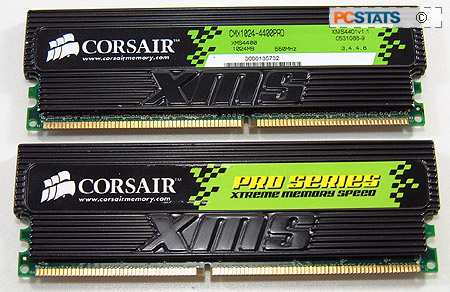A total of 1GB of system memory is no longer enough
for enthusiastic gamers if we are to believe some recent articles on the
web which look specifically at how the game Battlefield 2 handles. Nope, 2GB is
the new "1GB," and memory manufacturers are scrambling to make sure their
customers know this. Corsair Memory recently published a technical article
entitled; "AN506: Performance Impact on Changing Memory Size from 1GByte to 2
GByte" which explored the impact of memory capacity on several
applications including Doom3 and Battlefield 2. The results of that white paper show that higher memory capacity is close
to reaching the tipping point of where it transitions from a luxury to
necessity.
Of the six applications used in Corsairs'
AN506 white paper, only two saw significant improvements with
2GB of RAM installed. The remainder saw insignificant changes, and
the tests included both AMD and Intel platforms. In PCSTATS own tests, we
have basically seen that higher memory capacities affect a select few
applications, generally very recent programs or games, quite positively or not
at all. Battlefield 2 is the best current example in our benchmark
set.
However, faced with building a PC with 1GB or 2GB of
installed DDR to start with, the consumer has a couple decisions to make.
Though before making that decision, perhaps it is best to first
consider the effects of Corsair's new 2GB (2x 1024MB modules) TwinX2048-4400 PRO DDR RAM. Rated to run at speeds of up to 275 MHz, who says you had to sacrifice speed for larger capacity?
 |
|
Corsair TwinX2048-4400 PRO |
|
|
 | |
The memory is about 45mm in height, so users with cases where the CDROM overhangs the motherboard had best measure the clearances first. The heatspreaders for Corsair's PRO-series memory also house activity LEDs which are nice to gaze at through a side case window.
Each TwinX2048-4400 PRO memory module is rated for up to 275 MHz with 3-4-4-8 timings at a voltage of 2.8V. If you are more of a low latency guy however, you will be pleased to know that the DIMMs have no problems running tight timings at lower speeds with less voltage.
 |
| Overclocking Results: |
|
|
To start the overclocking, I first lowered the CPU multiplier to 6x, this way it will not limit the memory's maximum speed. Starting at 200 MHz and keeping tight 2-2-2-5 memory timings, I slowly increased the motherboard clock speed in 5 MHz intervals.
At 215 MHz the system had difficulty booting into Windows, it would BSOD every time. Increasing the memory voltage from 2.6V to 2.7V solved that issue and benchmarks ran just fine thereafter. I continued to push the motherboard higher and at 225 MHz the TwinX2048-4400 PRO memory again flaked out. The system would not boot and would lock up in the BIOS, so I had to lower the bus speed to 223 MHz and increase the voltage to 2.8V.
A speed of 223 MHz with 2-2-2-5 timings at 2.8V is not bad.... however this memory is intended to run faster with looser timings so that is exactly what we tested next. The memory timings were lowered to 3-4-4-8 (SPD) while 2.8V was maintained. The TwinX2048-4400 PRO had no problems hitting 275 MHz which was pretty sweet. The TwinX2048-4400 PRO memory did not want to go much higher than that though, and the maximum speed it reached was 284 MHz. Anything higher and the system would drop back to desktop while running 3D benchmarks. Raising the voltage higher than 2.8V did not help.
Next up, the benchmarks!

